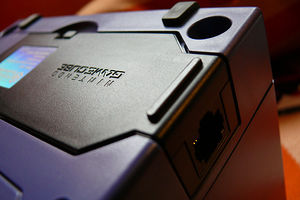Difference between revisions of "Broadband Adapter"
(Created page with "thumb|The GameCube BBA, attached to a GameCube The '''Nintendo GameCube Broadband Adapter''' is a network adapter for the [[Nintendo GameCube...") |
m (deleted 2 links) |
||
| Line 1: | Line 1: | ||
[[Image:Gcbba.jpg|thumb|The GameCube BBA, attached to a GameCube]] | [[Image:Gcbba.jpg|thumb|The GameCube BBA, attached to a GameCube]] | ||
| − | The '''Nintendo GameCube Broadband Adapter''' is a | + | The '''Nintendo GameCube Broadband Adapter''' is a network adapter for the [[Nintendo GameCube]]. They were produced by [[Conexant]] and made in the Philippines. The adapters fit flush into "Serial Port 1" on the underside of the GameCube and add a RJ-45 port to the side of the console. |
==Game== | ==Game== | ||
Revision as of 08:52, 28 April 2012
The Nintendo GameCube Broadband Adapter is a network adapter for the Nintendo GameCube. They were produced by Conexant and made in the Philippines. The adapters fit flush into "Serial Port 1" on the underside of the GameCube and add a RJ-45 port to the side of the console.
Game
| Title | Developer(s) | Online/LAN Play |
|---|---|---|
| Homeland | Chunsoft | Online |
| Phantasy Star Online Episode I & II | Sonic Team | Online |
| Phantasy Star Online Episode I & II Plus | Sonic Team | Online |
| Mario Kart: Double Dash!! | Nintendo | LAN |
| 1080° Avalanche | NST | LAN |
| Kirby Air Ride | HAL Laboratory | LAN |
Note: LAN games can be played online with third-party PC applications such as Warp Pipe and XLink Kai that allows online play of these three games by tunneling the network traffic through a computer and across the Internet.
Possibilities for running unsigned code
Soon after PSO I & II was released for the GameCube, it was discovered that a PC could be made to simulate the conditions of the server that the game would connect to. This information started as a method of tunneling the online service. When simulating this server, unsigned code can be streamed back to the GameCube, allowing homebrew, or information could be streamed back, allowing one to play copied games. This was also implemented to allow online gameplay in games for which it is not intended. Early dumps of GameCube games were created using this technique. From there, methods of running the games off of a computer through a GameCube were created. Nintendo and Sega responded by releasing the Plus version of the game.
Closure
The online gaming service was officially discontinued on April 2007. Nintendo discontinued the online service to focus more on the Nintendo Gamecube's successor, the Wii and its online gaming service. Although the service was discontinued, games can still be played online via private servers. Game that supported LAN mutiplayer can still be played on LAN mode as well and can be played online with tunneling software.
See Also
References
- http://en.wikipedia.org/wiki/Nintendo_GameCube_Broadband_Adapter_and_Modem_Adapter
- Picture of BBA by Ben Wood
- Broadband Adapter instruction booklet by Nintendo (PDF)
